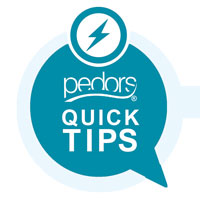Womens Venous Insufficiency Shoes by Pedors

By Stephen O'Hare, President and Co-Founder, Pedors Shoes
For over 25 years Pedors Shoes has designed and manufactured shoes for problem feet. Our goal is to get our customers back on their feet again with affordable, quality footwear that addresses their specific needs. We’re here to help. Your footwear problems are our challenges.
Womens Venous Insufficiency Shoes - A Buyers Guide For Women by Pedors Shoes
Venous insufficiency can affect both men and women, but it is more commonly reported in women. There are several reasons why venous insufficiency may be more prevalent in women, and the causes can be attributed to multiple reasons.
Factors that contribute to the higher incidence of venous insufficiency in women:
Pregnancy
One of the significant contributors to venous insufficiency in women is pregnancy. During pregnancy, the growing uterus exerts pressure on the veins in the pelvic region and inferior vena cava, hindering blood flow from the legs back to the heart. Hormonal changes during pregnancy also affect vein elasticity and may lead to the development of varicose veins.
Hormonal Changes
Female hormones, particularly estrogen and progesterone, play a role in the elasticity of blood vessels. Hormonal fluctuations during menstrual cycles, pregnancy, and menopause can impact vein function, making women more susceptible to venous insufficiency.
Use of Hormonal Contraceptives
Some forms of hormonal contraceptives, such as birth control pills or hormone replacement therapy (HRT), can affect vein function and contribute to venous insufficiency.
Genetics
Genetic factors can influence the development of venous insufficiency. If there is a family history of venous disorders, individuals, both men and women, may be at an increased risk.
Occupational Factors
Certain occupations that involve prolonged periods of standing or sitting may contribute to venous insufficiency. Women in professions that require extended periods of standing, such as teaching or nursing, may be more prone to developing venous issues.
Lifestyle Factors
Factors such as obesity and a sedentary lifestyle can contribute to the development of venous insufficiency. Women who are overweight or lead a predominantly sedentary lifestyle may be at an increased risk.
Age
Venous insufficiency becomes more common with age, and women may be more susceptible as they age.
High Heel Use
Wearing high-heeled shoes frequently may contribute to venous insufficiency. High heels can affect calf muscle function and blood circulation, increasing the risk of venous issues.
Venous insufficiency often presents with symptoms such as leg swelling, pain, aching, and the development of varicose veins. While certain risk factors may be more prevalent in women, it's essential to note that men can also develop venous insufficiency, and the condition should not be solely attributed to gender. Lifestyle modifications, compression therapy, and medical interventions are among the treatment options available for managing venous insufficiency, and individuals experiencing symptoms should seek medical evaluation for proper diagnosis and guidance.
What are the design features women with venous insufficiency should look for in footwear?
Women with venous insufficiency can benefit from choosing footwear that provides proper support, promotes healthy blood circulation, and minimizes discomfort associated with this condition. Here are design features to look for in footwear for women with venous insufficiency:
Compression and Support
Look for shoes that offer gentle compression, especially in the ankle and arch areas. This can aid in improving blood circulation. Supportive features like arch support and a firm heel counter can help reduce strain on the veins.
Low Heel Height
Opt for shoes with a low or flat heel. Higher heels can contribute to calf muscle fatigue and affect blood circulation, which may exacerbate venous insufficiency symptoms.
Wide Toe Box
Shoes with a wide toe box provide ample room for the toes and help reduce pressure on the front of the foot. This is particularly important for individuals with bunions, hammertoes, or other toe deformities.
Adjustable Closures
Shoes with adjustable closures, such as Velcro straps or laces, allow for a customized and secure fit. This is beneficial for accommodating any changes in foot swelling throughout the day.
Cushioning
Adequate cushioning in the insole and midsole provides shock absorption, reducing the impact on the feet. This can be especially helpful for individuals with venous insufficiency who may experience discomfort or pain.
Lightweight Construction
Lightweight shoes are more comfortable for extended periods of wear. They reduce fatigue and make walking easier for women with venous insufficiency.
Breathable Materials
Choose shoes made from breathable materials, such as mesh or leather, to maintain a comfortable temperature and reduce the risk of moisture-related skin issues.
Removable Insoles
Shoes with removable insoles allow for customization with orthotic inserts or additional padding, providing personalized comfort and support.
Non-Slip Outsoles
Shoes with non-slip or slip-resistant outsoles provide stability and reduce the risk of slips and falls, which is important for individuals with compromised circulation.
Diabetic-Friendly Features
Some individuals with venous insufficiency may also have diabetes. Shoes with diabetic-friendly features, such as extra depth and a seamless interior, can be beneficial.
Room for Swelling
Choose shoes that provide some extra room to accommodate potential foot swelling, which is a common symptom of venous insufficiency.
Stylish Options
There are many stylish and supportive footwear options available. Look for brands that combine fashion with function, so you can maintain a sense of style while prioritizing foot health.
It's important for women with venous insufficiency to consult with healthcare professionals, such as a podiatrist or vascular specialist, for personalized advice on footwear. Additionally, getting professionally fitted for shoes can ensure the proper size and fit, contributing to overall foot health.
Conclusion on the Pedors Guide to Womens Venous Insufficiency Shoes
If you have any questions please don't hesitate to email us at support@pedors.com or call 1-800-750-6729 if in the USA or +1 770 218 8282 if outside the USA.

